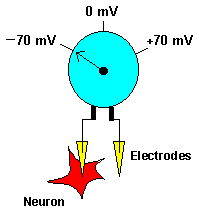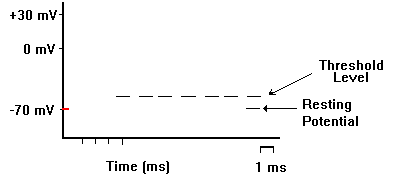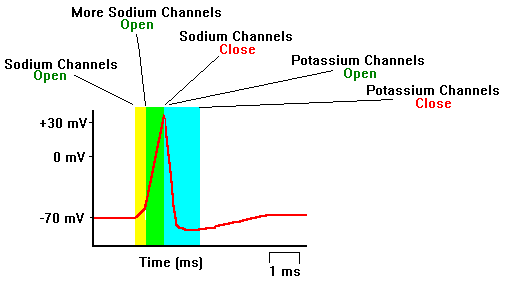Neuroscience For Kids
Lights, Camera, Action Potential Lights, Camera, Potensi Aksi
 This page describes how neurons work. Halaman ini menjelaskan cara neuron bekerja. I hope this explanation does not get too complicated, but it is important to understand how neurons do what they do. Saya harap penjelasan ini tidak terlalu rumit, tetapi penting untuk memahami bagaimana neuron melakukan apa yang mereka lakukan. There are many details, but go slow and look at the figures. Ada banyak rincian, tapi pergi lambat dan melihat angka.
This page describes how neurons work. Halaman ini menjelaskan cara neuron bekerja. I hope this explanation does not get too complicated, but it is important to understand how neurons do what they do. Saya harap penjelasan ini tidak terlalu rumit, tetapi penting untuk memahami bagaimana neuron melakukan apa yang mereka lakukan. There are many details, but go slow and look at the figures. Ada banyak rincian, tapi pergi lambat dan melihat angka.  Much of what we know about how neurons work comes from experiments on the giant axon of the squid. Banyak dari apa yang kita ketahui tentang bagaimana neuron bekerja berasal dari percobaan pada akson cumi raksasa tersebut. This giant axon extends from the head to the tail of the squid and is used to move the squid's tail. Akson raksasa ini memanjang dari kepala ke ekor cumi-cumi dan digunakan untuk memindahkan ekor cumi-cumi itu. How giant is this axon? Bagaimana akson raksasa ini? It can be up to 1 mm in diameter - easy to see with the naked eye. Ini bisa sampai 1 mm - mudah untuk melihat dengan mata telanjang.
Much of what we know about how neurons work comes from experiments on the giant axon of the squid. Banyak dari apa yang kita ketahui tentang bagaimana neuron bekerja berasal dari percobaan pada akson cumi raksasa tersebut. This giant axon extends from the head to the tail of the squid and is used to move the squid's tail. Akson raksasa ini memanjang dari kepala ke ekor cumi-cumi dan digunakan untuk memindahkan ekor cumi-cumi itu. How giant is this axon? Bagaimana akson raksasa ini? It can be up to 1 mm in diameter - easy to see with the naked eye. Ini bisa sampai 1 mm - mudah untuk melihat dengan mata telanjang. Neurons send messages electrochemically . Neuron mengirim pesan elektrokimia. This means that chemicals cause an electrical signal. Ini berarti bahwa bahan kimia menyebabkan sinyal listrik. Chemicals in the body are "electrically-charged" -- when they have an electrical charge, they are called ions. The important ions in the nervous system are sodium and potassium (both have 1 positive charge, +), calcium (has 2 positive charges, ++) and chloride (has a negative charge, -). Bahan kimia dalam tubuh adalah "elektrik-diisi" - mereka memiliki listrik, muatan mereka disebut ion. Ketika The ion penting dalam sistem saraf adalah natrium dan kalium (keduanya memiliki 1 muatan positif, +), kalsium (memiliki 2 positif biaya, + +) dan klorida (memiliki muatan negatif, -). There are also some negatively charged protein molecules. Ada juga beberapa molekul protein bermuatan negatif. It is also important to remember that nerve cells are surrounded by a membrane that allows some ions to pass through and blocks the passage of other ions. Hal ini juga penting untuk diingat bahwa sel-sel saraf dikelilingi oleh membran yang memungkinkan beberapa ion untuk melewati dan blok bagian ion lainnya. This type of membrane is called semi-permeable . Jenis membran yang disebut semi-permeable.
Resting Membrane Potential Istirahat Potensial Membran
 When a neuron is not sending a signal, it is "at rest." Ketika neuron tidak mengirim sinyal, itu adalah "saat istirahat." When a neuron is at rest, the inside of the neuron is negative relative to the outside. Ketika neuron adalah di istirahat, bagian dalam neuron relatif negatif ke luar. Although the concentrations of the different ions attempt to balance out on both sides of the membrane, they cannot because the cell membrane allows only some ions to pass through channels (ion channels). Meskipun konsentrasi ion-ion yang berbeda berusaha untuk menyeimbangkan keluar pada kedua sisi membran, mereka tidak bisa karena selaput sel memungkinkan hanya beberapa ion untuk melewati saluran (saluran ion). At rest, potassium ions (K + ) can cross through the membrane easily. Saat istirahat, ion kalium (K +) dapat menyeberang melalui membran mudah. Also at rest, chloride ions (Cl - )and sodium ions (Na + ) have a more difficult time crossing. Juga saat istirahat, ion klorida (Cl -) dan ion natrium (Na +) memiliki lebih banyak waktu yang sulit melintasi. The negatively charged protein molecules (A - ) inside the neuron cannot cross the membrane. Molekul protein bermuatan negatif (A -) di dalam neuron tidak dapat menyeberangi membran.
When a neuron is not sending a signal, it is "at rest." Ketika neuron tidak mengirim sinyal, itu adalah "saat istirahat." When a neuron is at rest, the inside of the neuron is negative relative to the outside. Ketika neuron adalah di istirahat, bagian dalam neuron relatif negatif ke luar. Although the concentrations of the different ions attempt to balance out on both sides of the membrane, they cannot because the cell membrane allows only some ions to pass through channels (ion channels). Meskipun konsentrasi ion-ion yang berbeda berusaha untuk menyeimbangkan keluar pada kedua sisi membran, mereka tidak bisa karena selaput sel memungkinkan hanya beberapa ion untuk melewati saluran (saluran ion). At rest, potassium ions (K + ) can cross through the membrane easily. Saat istirahat, ion kalium (K +) dapat menyeberang melalui membran mudah. Also at rest, chloride ions (Cl - )and sodium ions (Na + ) have a more difficult time crossing. Juga saat istirahat, ion klorida (Cl -) dan ion natrium (Na +) memiliki lebih banyak waktu yang sulit melintasi. The negatively charged protein molecules (A - ) inside the neuron cannot cross the membrane. Molekul protein bermuatan negatif (A -) di dalam neuron tidak dapat menyeberangi membran.  In addition to these selective ion channels, there is a pump that uses energy to move three sodium ions out of the neuron for every two potassium ions it puts in. Finally, when all these forces balance out, and the difference in the voltage between the inside and outside of the neuron is measured, you have the resting potential . Selain saluran ion selektif, ada pompa yang menggunakan energi untuk memindahkan tiga ion natrium keluar dari neuron untuk setiap dua ion kalium menempatkan masuk Akhirnya, ketika semua keseimbangan kekuatan keluar, dan perbedaan tegangan antara di dalam dan di luar neuron diukur, Anda memiliki potensial istirahat. The resting membrane potential of a neuron is about -70 mV (mV=millivolt) - this means that the inside of the neuron is 70 mV less than the outside. Potensi istirahat membran neuron adalah sekitar -70 mV (mV = millivolt) - ini berarti bahwa bagian dalam neuron adalah 70 mV kurang dari luar. At rest, there are relatively more sodium ions outside the neuron and more potassium ions inside that neuron. Saat istirahat, ada relatif ion natrium lebih luar neuron dan ion kalium lebih dalam neuron itu.
In addition to these selective ion channels, there is a pump that uses energy to move three sodium ions out of the neuron for every two potassium ions it puts in. Finally, when all these forces balance out, and the difference in the voltage between the inside and outside of the neuron is measured, you have the resting potential . Selain saluran ion selektif, ada pompa yang menggunakan energi untuk memindahkan tiga ion natrium keluar dari neuron untuk setiap dua ion kalium menempatkan masuk Akhirnya, ketika semua keseimbangan kekuatan keluar, dan perbedaan tegangan antara di dalam dan di luar neuron diukur, Anda memiliki potensial istirahat. The resting membrane potential of a neuron is about -70 mV (mV=millivolt) - this means that the inside of the neuron is 70 mV less than the outside. Potensi istirahat membran neuron adalah sekitar -70 mV (mV = millivolt) - ini berarti bahwa bagian dalam neuron adalah 70 mV kurang dari luar. At rest, there are relatively more sodium ions outside the neuron and more potassium ions inside that neuron. Saat istirahat, ada relatif ion natrium lebih luar neuron dan ion kalium lebih dalam neuron itu. Action Potential Aksi Potensi

 Action potentials are caused by an exchange of ions across the neuron membrane. Aksi potensi disebabkan oleh pertukaran ion melewati membran neuron. A stimulus first causes sodium channels to open. Sebuah stimulus pertama menyebabkan saluran natrium untuk membuka. Because there are many more sodium ions on the outside, and the inside of the neuron is negative relative to the outside, sodium ions rush into the neuron. Karena ada ion natrium lebih banyak lagi di luar, dan bagian dalam neuron negatif relatif ke luar, ion natrium buru-buru ke neuron. Remember, sodium has a positive charge, so the neuron becomes more positive and becomes depolarized. Ingat, natrium memiliki muatan positif, sehingga neuron menjadi lebih positif dan menjadi depolarized. It takes longer for potassium channels to open. Perlu waktu lebih lama untuk saluran kalium untuk membuka. When they do open, potassium rushes out of the cell, reversing the depolarization. Ketika mereka membuka, kalium bergegas keluar dari sel, membalikkan depolarisasi. Also at about this time, sodium channels start to close. Juga pada sekitar saat ini, saluran natrium mulai dekat. This causes the action potential to go back toward -70 mV (a repolarization). Hal ini menyebabkan tindakan potensi untuk kembali ke -70 mV (repolarisasi a). The action potential actually goes past -70 mV (a hyperpolarization) because the potassium channels stay open a bit too long. Potensial aksi benar-benar pergi melampaui -70 mV (hyperpolarization a) karena saluran kalium tetap terbuka agak terlalu lama. Gradually, the ion concentrations go back to resting levels and the cell returns to -70 mV. Secara bertahap, konsentrasi ion kembali ke tingkat sel beristirahat dan kembali ke -70 mV.
Action potentials are caused by an exchange of ions across the neuron membrane. Aksi potensi disebabkan oleh pertukaran ion melewati membran neuron. A stimulus first causes sodium channels to open. Sebuah stimulus pertama menyebabkan saluran natrium untuk membuka. Because there are many more sodium ions on the outside, and the inside of the neuron is negative relative to the outside, sodium ions rush into the neuron. Karena ada ion natrium lebih banyak lagi di luar, dan bagian dalam neuron negatif relatif ke luar, ion natrium buru-buru ke neuron. Remember, sodium has a positive charge, so the neuron becomes more positive and becomes depolarized. Ingat, natrium memiliki muatan positif, sehingga neuron menjadi lebih positif dan menjadi depolarized. It takes longer for potassium channels to open. Perlu waktu lebih lama untuk saluran kalium untuk membuka. When they do open, potassium rushes out of the cell, reversing the depolarization. Ketika mereka membuka, kalium bergegas keluar dari sel, membalikkan depolarisasi. Also at about this time, sodium channels start to close. Juga pada sekitar saat ini, saluran natrium mulai dekat. This causes the action potential to go back toward -70 mV (a repolarization). Hal ini menyebabkan tindakan potensi untuk kembali ke -70 mV (repolarisasi a). The action potential actually goes past -70 mV (a hyperpolarization) because the potassium channels stay open a bit too long. Potensial aksi benar-benar pergi melampaui -70 mV (hyperpolarization a) karena saluran kalium tetap terbuka agak terlalu lama. Gradually, the ion concentrations go back to resting levels and the cell returns to -70 mV. Secara bertahap, konsentrasi ion kembali ke tingkat sel beristirahat dan kembali ke -70 mV.
Tidak ada komentar:
Posting Komentar